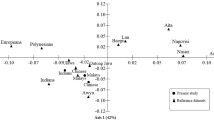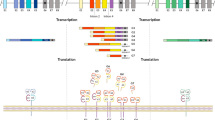Abstract
The Duffy blood group system was named for a polytransfused hemophiliac man in whose serum a new antibody was found (Cutbush et al. 1950). “Duffy” was the patient’s last name and the authors used this name for the new blood group system (Cutbush and Molisson 1950). The system consists of two principal antigens, Fya and Fyb, produced by FY*A and FY*B codominant alleles. Antisera, anti-Fya and anti-Fyb define four phenotypes: Fy(a+b-), Fy(a-b+), Fy(a+b+) and Fy(a-b-). Subsequently, several Duffy antigens were found and named Fy3 (Albrey et al. 1971), Fy4 (Behzad et al. 1973) and Fy5 (Colledge et al. 1973). Recently, the murine monoclonal antibody, anti-Fy6, identified the Fy6 antigen (Nichols et al. 1987; Riwom et al. 1994).
Access this chapter
Tax calculation will be finalised at checkout
Purchases are for personal use only
Preview
Unable to display preview. Download preview PDF.
Similar content being viewed by others
References
Anderson RGW, Kamen BA, Rothberg KG, Lacey SW. Potocytosis: sequestration and trans-port of small molecules by caveolae. Science 255: 410–411, 1992
Barnwell JW, Nichols ME, Rubinstein P. In vitro evaluation of the role of the Duffy blood group in erythrocyte invasion by Plasmodium vivax. J Exp Med 169:1795–1802, 1989
Beattie KM: The Duffy Blood Group System. In: Pierce SR, Macpherson CR (eds) Blood group systems: Duffy, Kidd, and Lutheran. American Association of Blood Banks, Arlington VA, pp 1–25, 1988
Behzad O, Lee CL, Gavin J, Marsh WL. A new anti-erythrocyte antibody in the Duffy system: anti-Fy4. Vox Sang 24: 337–342, 1973
Bennett V. The membrane skeleton of human erythrocytes and its implications for more complex cells. Annu Rev Biochem 54: 273–304, 1985
Bloy C, Blanchard D, Lambin P, Goossens D, Rouger P, Salmon C, Cartron J-P. Human monoclonal antibody against Rh(D) antigen: partial characterization of the Rh(D) polypeptide from human erythrocytes. Blood 69: 1491–1497, 1987
Brosius FC, Alper SL, Garcia AM, Lodish HF. The major kidney band 3 gene transcript predicts an amino-terminal truncated, band 3: polypeptide. J Biol Chem 264: 7784–7787, 1989
Buchanan DI, Sinclair M, Sanger R, Gavin J, Teesdale P. An Alberta Cree Indian with a rare Duffy antibody anti-Fy3. Vox Sang 27: 619–624, 1976
Chaudhuri A, Pogo AO. The Duffy blood group system and malaria. In: Cartron J-P, Rouger P (eds) Blood cell biochemistry, vol 6. Plenum, New York, pp 243–265, 1995
Chaudhuri A, Zbrzezna V, Johnson C, Nichols ME, Rubinstein P, Marsh WL, Pogo A0. Purification and characterization of an erythrocyte protein complex carrying Duffy blood group antigenicity. J Biol Chem 264: 13770–13774, 1989
Chaudhuri A, Polyakova J, Zbrzezna V, Williams K, Gulati S, Pogo A0. Cloning of glycoprotein D cDNA, which encodes the major subunit of the Duffy blood group system and the receptor for the Plasmodium vivax malaria parasite. Proc Natl Acad Sci USA 9o: 10793–10797, 1993
Chaudhuri A, Zbrzezna V, Polyakova J, Pogo AO, Hesselgesser J, Horuk R. Expression of the Duffy antigen in K562 cells. J Biol Chem 269: 7835–7838, 1994
Chaudhuri A, Polyakova J, Zbrzezna V, Pogo A0. The coding sequence of Duffy blood group gene in humans and simians: restriction fragment length polymorphism antibody and malarial specificities and expression in nonerythroid tissues in Duffy-negative individuals. Blood 85: 615–621, 1995
Chitnis et al., 1996 (see Note added) in Proof.
Chown B, Lewis M, Kaita H. The Duffy blood group system in Caucasians: evidence for a new allele. Am J Hum Genet 17: 384–389, 1965
Colledge KI, Pezzulich M, Marsh WL. Anti-Fy5 an antibody disclosing a probable associa-tion between the Rhesus and Duffy blood group genes. Vox Sang 24: 193–199, 1973
Collins A, Keats BJ, Dracopoli N, Shields DC, Morton NE. Integration of gene maps: chro-mosome 1. Proc Natl Acad Sci USA 89: 4598–4602, 1992
Cutbush M, Mollison PL. The Duffy blood system. Heredity 4: 383–389, 1950
Cutbush M, Mollison PL, Parkin DM. A new human blood group. Nature 165: 188–189, 1950
Darbonne WC, Rice GC, Mohler MA, Apple T, Hebert CA, Valente AJ, Baker JB. Red blood cells are a sink for interleukin 8, a leukocyte chemotaxin. J Clin Invest 88: 1362–1369, 1991
DiNapoli J, Garcia A, Marsh WL, Dreizin D. A second example of anti-Fy5. Vox Sang 30: 308–311, 1976
Donahue RP, Bias WB, Renwick JH, McKusick VA. Probable assignment of the Duffy blood group locus to chromosome 1 in man. Proc Natl Acad Sci USA 61: 949–955, 1968
Dracopoli NC, O’Connell P, Elsner TI, Lalouel JM, White RL, Beutow KH, Nishimura DY, Murray JC, Helms C, Mishra SK, Donis-Keller H, Hall JM, Lee MK, King MC, Attwood J, Morton NE, Robson EB, Mahtani M, Willard HF, Royle NJ, Patel I, Jeffreys AJ, Verga V, Jenkins T, Weber JL, Mitchell AL, Bale AE. The CEPH consortium linkage map of human chromosome 1. Genomics 9: 686–700, 1991
Engelman DM, Steitz TA, Goldman A. Identifying nonpolar transbilayer helices in aminoacid sequences of membrane proteins. Annu Rev Biophys Chem 15: 321–353, 1986
Fleagle JG. Primate adaptation and evolution. Academic, London, p 259, 1988
Galinski MR, Corredor Medina C, Ingravallo P, Barnwell JW. A reticulocite-binding protein complex of plasmodium vivax merozoites. Cell 69: 1213–1226, 1992
Hadley TJ, David PH, McGinnis MH, Miller LH. Identification of an erythrocyte component carrying the Duffy blood group Fya antigen. Science 223: 597–599, 1984
Hadley TJ, Lu Z, Wasniowska K, Martin AW, Peiper SC, Hesselgesser J, Horuk R. Postcapillary venule endothelial cells in kidney express a multispecific chemokine receptor that is structurally and functionally identical to the erythroid isoform, which is the Duffy blood group antigen. J Clin Invest 94: 985–991, 1994
Hitzeroth HW, Bender K, Burckhardt K. South African negroes: serogenetic polymorphisms (ABO, Rhesus, MNS, Duffy and Kell) and inter-ethnic genetic distances. Acta Anthropogenet 6 (3): 171–193, 1982
Horuk R, Chitnis CE, Darbonne WC, Colby TJ, Rybicki A, Hadley TJ, Miller LH. A receptor for the malarial parasite Plasmodium vivax: the erythrocyte chemokine receptor. Science 261: 1182–1184, 1993
Iwamoto S, Omi T, Kajii E, Ikemoto S. Genomic organization of the glycoprotein D gene: duffy blood group Fya/Fyb alloantigen system is associated with a polymorphism at the 44-amino acid residue. Blood 85: 622–626, 1995
Iwamoto S, Li J, Omi T, Ikemoto S, Kajii E. Identification of a novel exon and spliced form of Duffy mRNA that is the predominant transcript in both erythroid and postcapillary venule endothelium. Blood 87: 378–385, 1996
Mallinson G, Soo KS, Schall TJ, Pisacka M, Anstee DJ. Mutations in the erythrocyte chemokine receptor (Duffy) gene: the molecular basis of the Fya/Fyb antigens and identification of a deletion in the Duffy gene of an apparently healthy individual with the Fy(a-b-) phenotype. Br J Haematol 90: 823–829, 1995
Marsh WL. Present status of the Duffy blood group system. Grit Rev Clin Lab Sci 5: 387–412, 1975
Marshall RD. Glycoproteins. Ann Rev Biochem, pp 673–702, 1972
Mathew S, Chaudhuri A, Murty VVVS, Pogo AO. Confirmation of Duffy blood group antigen locus (FY) at 1q22 → q23 by fluorescence in situ hybridization. Cytogenet Cell Genet 67: 68, 1994
McGinniss MH, Miller LH. Malaria, erythrocyte receptors and the Duffy blood group system. In: Steane EA (ed) Cellular antigens and disease. American Association of Blood Banks, Washington DC, pp 67–77, 1977
Miller LH, Mason SJ, Dvorak JA, McGinniss MH, Rothman IK. Erythrocyte receptors for (Plasmodium knowlesi) malaria: Duffy blood group determinants. Science 189: 561–563, 1975
Miller LH, Mason SJ, Clyde DF, McGinniss MH. The resistance factor to Plasmodium vivax in blacks. The Duffy blood group genotype FyFy. N Engl J Med 295: 303–304, 1976
Moore S, Woodrow CF, McClelland DBL. Isolation of membrane components associated with human red cell antigens Rh(D),(c), (E) and Fya. Nature 295: 529–531, 1982
Neote K, Mak JY, Kolakowski LF, Schall TJ. Functional and biochemical analysis of the cloned Duffy antigen: identity with the red blood cell chemokine receptor. Blood 84: 44–52, 1994
Nichols ME, Rubinstein P, Barnwell JD, de Cordoba SR, Rosenfield RE. A new human Duffy blood group specificity defined by a murine monoclonal antibody. J Exp Med 166: 776–785, 1987
Oberdorfer CE, Kahn B, Moore V, Zelenski K, Oyen R, Marsh WL. A second example of anti-Fy3 in the Duffy blood group system. Transfusion 14: 608–611, 1974
Palatnik M, Rowe AW. Duffy and Duffy-related human antigens in primates. J Hum Evol 13: 173–179, 1984
Peiper SC, Wang Z-X, Neote K, Martin AW, Showell HJ, Conklyn MJ, Ogborne K, Hadley TJ, Zhao-hai L, Hesselgesser J, Horuk R. The Duffy antigen/receptor for chemokines (DARC) is expressed in endothelial cells of Duffy negative individuals, who lack the erythrocyte receptor. J Exp Med 181: 1311–1317, 1995
Riwom S, Janvier D, Navenot JM, Benbunan M. Muller JY, Blanchard D. Prooduction of a new murine monoclonal antibody with Fy6 specificity and characterization of the immunopurified N-glycosylated Duffy-active molecule. Vox Sang 66: 61–67, 1994
Salmon C, Cartron J-P, Rouger R. The human blood groups. Masson, New York, pp 249–255, 1984
Sanger R, Race RR, Jack JA. The Duffy blood groups of New York Negroes The phenotype Fy(a-b-). Br J Haematol 1: 370–374, 1955
Tanner MJA, Anstee DJ, Mallinson G, Ridgwell K, Martin PG, Aventi ND, Parsons SF. Effect of endoglycosidase F-peptidyl N-glycosidase F preparations on the surface components of the human erythrocyte. Carbohydr Res 178: 203–212, 1988
Tournamille C, Colin Y, Cartron J-P, Le Van Kim C. Disruption of a GATA motif in the Duffy gene promoter abolishes erythroid gene expression in Duffy-negative individuals. Nat Genet 10: 224–228, 1995
Waters AP, Higgins DG, McCutchan TF. Plasmodium falciparum appears to have arisen as a result of lateral transfer between avian and human. Proc Natl Acad Sci USA 88: 3140–3144, 1991
Wertheimer SP, Barnwell JW. Plasmodium vivax interaction with human Duffy blood group glycoprotein: identification of a parasite receptor-like protein. Exp Parasitol 69: 340–350, 1989
Wertheimer SP, Barnwell JW. Plasmodium vivax interaction with human Duffy blood group glycoprotein: identification of a parasite receptor-like protein. Exp Parasitol 69: 340–350, 1989
Albrey JA, Vincent EER, Hutchinson J, Marsh WL, Allen FH, Gavin J, Sanger R. A new antibody, anti-Fy3, in the Duffy blood group system. Vox Sang 20: 29–35, 1971
Editor information
Editors and Affiliations
Rights and permissions
Copyright information
© 1997 Springer-Verlag Berlin Heidelberg
About this chapter
Cite this chapter
Pogo, A.O., Chaudhuri, A. (1997). The Duffy Blood Group System and Its Extensions in Nonhuman Primates. In: Blancher, A., Klein, J., Socha, W. (eds) Molecular Biology and Evolution of Blood Group and MHC Antigens in Primates. Springer, Berlin, Heidelberg. https://doi.org/10.1007/978-3-642-59086-3_7
Download citation
DOI: https://doi.org/10.1007/978-3-642-59086-3_7
Publisher Name: Springer, Berlin, Heidelberg
Print ISBN: 978-3-642-63843-5
Online ISBN: 978-3-642-59086-3
eBook Packages: Springer Book Archive




